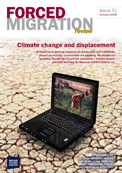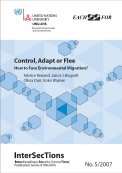(The Guardian UK) May 18, 2009 – When the desert winds tear up the sands outside his front door, Huang Cuikun, pictured below in a dried-up riverbed near his home, says he is choked by dust, visibility falls to a few metres and the crops are ruined.
Dust storms hit his village in Gansu province more often than in the past. The water table is falling. Temperatures rise year by year. Yet Huang says this is an improvement. Three years ago the government relocated him from an area where the river ran dry and the well became so salinated that people who drank from it fell sick.
“Life is easier now,” he says, puffing on a cigarette in the new brick home that the authorities have given him. “When we lived in Donghuzhen, we had little water and the crops couldn’t grow. Our income was tiny and we were very poor.”
Huang is one of millions of Chinese eco-refugees who have been resettled because their home environments degraded to the point where they were no longer fit for human habitation. The government says more than 150 million people will have to be moved. Water shortages exacerbated by over-irrigation and climate change are the main cause.
The problem is most severe in the north-west, where desert sands are swallowing up farmland, homes and towns. Huang lives in Mingqin, a shrinking oasis area that government advisers privately describe as an “ecological disaster area”.
The Yellow river is diverted more than 62 miles (100km) to replenish dried-up reservoirs and aquifers in Minqin, where the population has swollen from 860,000 to 2.3 million over the last 60 years, even as water supplies have declined.
It is not enough. The Tengger desert is encroaching from the south-east and the Badain Jaran desert from the north-west. Since 1950 the oasis has shrunk by 111 square miles (288 sq km), while the number of annual superdust storms has increased more than fourfold. In Liangzhou district, 240 of the 291 springs have dried up.
Global warming is adding to the problem. Evaporation rates are rising, along with temperatures. According to a study by the Centre for Agricultural Water Research in China, 64% of the reduced stream-flow in the area is attributable to climate variation.
The government pays many farmers to cease production and has relocated thousands of others, like Huang, out of the worst affected areas. The government has given him a new home and land, but the desert winds still howl outside the door and his fields are bordered by sand dunes. Workers in the fields wear masks to protect their faces from the dust storms that whip in from the dunes.
Huang likes his new home, but with the climate getting hotter and drier, he cannot be complacent that it is secure from the sands.
“It’s just 2km or 3km from here to the desert, says Huang, so we have taken every measure we can think of to stop the desert moving closer.To survive, we must control the desert. Huang know the trees alone cannot save his home. “In Minqin, our greatest need is water. That is our lifeline. Without water, we cannot survive.”
Source: The Guardian UK
Related Links:
“China: Environmental Refugees” – Sean Gallagher, for the Pulitzer Center




Hi, good post. I have been wondering about this issue,so thanks for posting. I’ll definitely be coming back to your site.